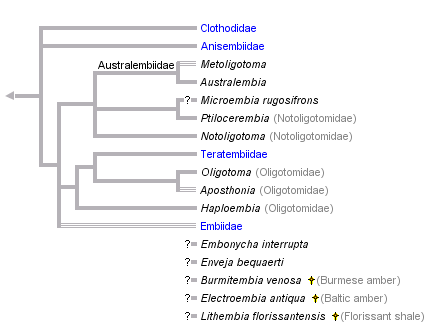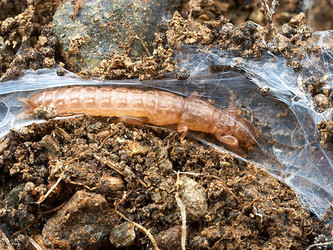Embiidina
Web spinners



This tree diagram shows the relationships between several groups of organisms.
The root of the current tree connects the organisms featured in this tree to their containing group and the rest of the Tree of Life. The basal branching point in the tree represents the ancestor of the other groups in the tree. This ancestor diversified over time into several descendent subgroups, which are represented as internal nodes and terminal taxa to the right.

You can click on the root to travel down the Tree of Life all the way to the root of all Life, and you can click on the names of descendent subgroups to travel up the Tree of Life all the way to individual species.
For more information on ToL tree formatting, please see Interpreting the Tree or Classification. To learn more about phylogenetic trees, please visit our Phylogenetic Biology pages.
close boxCharacteristics
- foretarsus modified with silk glands
- live in silken tubes
- wings very flexible; with blood sinus in radius (RBS)
- wingless females
- highly asymmetrical male genitalia
References
Davis, C. 1939. Taxonomic notes of the Order Embioptera. Part III: The genus Burmitembia Cockerell. Proceedings of the Linnean Society of New South Wales 64:369-373.
Davis, C. 1940. Family classification of the Order Embioptera. Annals of the Entomological Society of America 33:677-682.
Davis, C. 1940. Taxonomic notes of the Order Embioptera. Part XX: The distribution and comparative morphology of the Order Embioptera. Proceedings of the Linnean Society of New South Wales 65:533-542.
Edgerly, J. S. 1997. Life beneath silk walls: A review of the primitively social Embiidina. Pages 14-25 in The Evolution of Social Behavior in Insects and Arachnids. J. Choe and B. Crespi, eds. Cambridge University Press.
Edgerly, J. S., J. A. Davilla, and N. Schoenfeld. 2002. Silk spinning behavior and domicile construction in webspinners. Journal of Insect Behavior 15(2):219-242.
Edgerly, J. S., C. A. Szumik, and C. N. McCreedy. 2007. On new characters of the eggs of Embioptera with the description of a new species of Saussurembia (Anisembiidae). Systematic Entomology 32:387–395.
Ross, E. S. 1940. A revision of the Embioptera of North America. Annals of the Entomological Society of America 33:629-676.
Ross, E. S. 1944. A revision of the Embioptera, or web-spinners, of the New World. Proceedings of the U.S. National Museum 94:401-504.
Ross, E. S. 1957. The Embioptera of California. Bull. Calif. Insect Sur. 6:51-57.
Ross, E. S. 1970. Biosystematics of the Embioptera. Annual Review of Entomology 15:157-172.
Ross, E. S. 1984. A synopsis of the Embiidina of the United States. Proceedings of the Entomological Society of Washington 86:82-93.
Ross, E. S. 1984. A classification of the Embiidina of Mexico with descriptions of new taxa. Occasional Papers of the California Academy of Sciences 140:1-50.
Ross, E. S. 1992. Webspinners of Panama (Embiidina). Pages 122-141 in Insects of Panama and Mesoamerica: Selected Studies. D. Quintero and A. Aiello, eds. Oxford University Press, Oxford, New York & Tokyo.
Ross, E. S. 2000. Embia: Contributions to the biosystematics of the insect order Embiidina. Occasional Papers of the California Academy of Sciences 149:1-53.
Szumik, C. A. 1996. The higher classification of the order Embioptera: A cladistic analysis. Cladistics 12:41-64.
Szumik, C. A. 1997. Two new neotropical genera of Embiidae (Embioptera, Insecta). Journal of the New York Entomological Society 105(3-4):140-153.
Szumik, C. A. 2001. Nuevos Embiopteros de America del Sur. [New South American Embioptera.] Revista de la Sociedad Entomologica Argentina 60(1-4):257-272.
Szumik, C. A. 2004. Phylogenetic systematics of Archembiidae (Embiidina, Insecta). Systematic Entomology 29(2):215-237.
Valentine, B. D. 1986. Grooming behavior in Embioptera and Zoraptera (Insecta). Ohio Journal Of Science 86(4): 150-152.
Information on the Internet
- World List of Extant and Fossil Embiidina. Edward S. Ross, California Academy of Sciences.
- Checklist of South African Embiidina
Title Illustrations

| Scientific Name | Haploembia solieri |
|---|---|
| Location | Lake Co., California, U.S.A. |
| Specimen Condition | Live Specimen |
| Life Cycle Stage | Adult |
| Copyright |
© 2005 Alex Wild

|
| Scientific Name | Oligotoma nigra |
|---|---|
| Location | Tucson, AZ, USA |
| Specimen Condition | Live Specimen |
| Identified By | Alex Wild |
| Sex | Male |
| Life Cycle Stage | Adult |
| Copyright |
© 2007 Alex Wild

|
About This Page
Page copyright © 2002
All Rights Reserved.
Citing this page:
Tree of Life Web Project. 2002. Embiidina. Web spinners. Version 01 January 2002 (temporary). http://tolweb.org/Embiidina/8248/2002.01.01 in The Tree of Life Web Project, http://tolweb.org/









 Go to quick links
Go to quick search
Go to navigation for this section of the ToL site
Go to detailed links for the ToL site
Go to quick links
Go to quick search
Go to navigation for this section of the ToL site
Go to detailed links for the ToL site